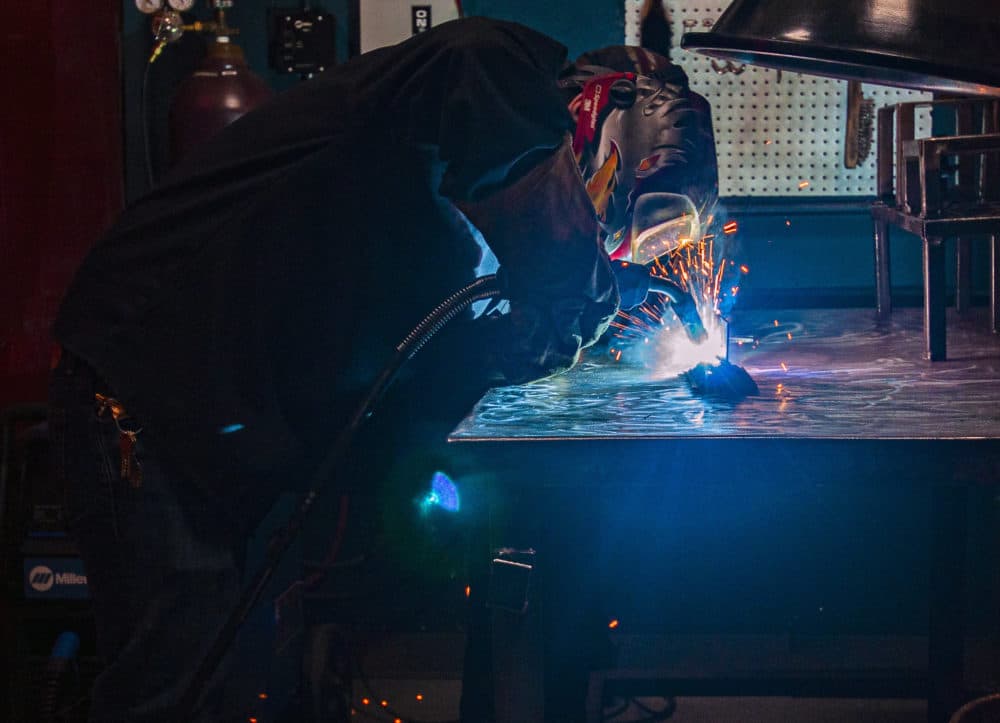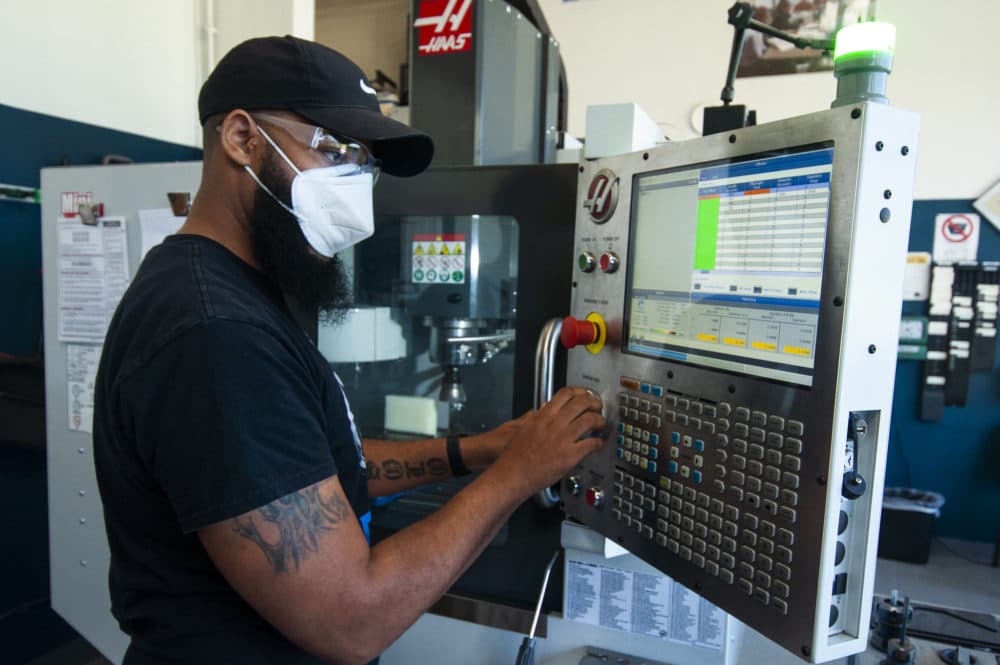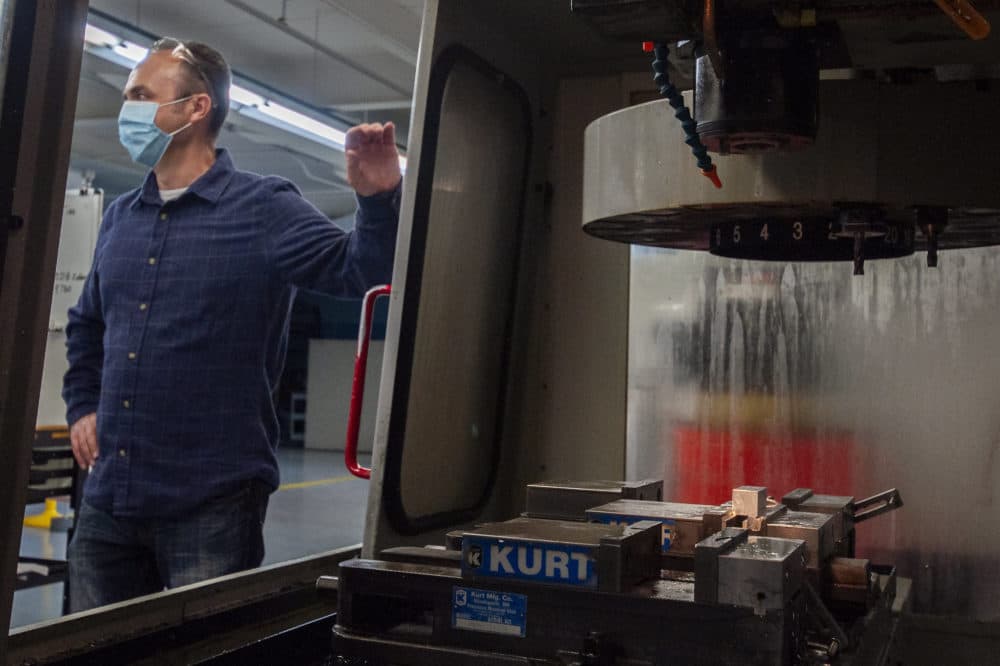Advertisement
U.S. Manufacturers Can't Find Enough Skilled Workers To Fill Open Jobs

Adonis Summerville punches coordinates into a computer numerical control milling machine, giving instructions to a robotic arm that will cut a block of plastic, wood or metal into a precise shape. It could become anything from an electrical outlet to a medical screw used in surgery.
This particular machine is used mostly for demonstrations, because Summerville is a teacher at the Jane Addams Resource Corporation, a nonprofit in Chicago that trains people in skills needed to land manufacturing jobs.
As lawmakers squabble over the size of President Biden's infrastructure plan, there's bipartisan agreement on at least one of its goals: reviving manufacturing. The administration wants to reverse a long-term decline in manufacturing jobs and it's promising billions of dollars for workforce training programs like this one to help do that.
Summerville is a teacher now, but 10 years ago he had just enrolled as a student at the school. Back then, he was a young, unemployed father recently released from prison.
“Once my kid came into the world I figured I had to do something,” says Summerville, now 33. He recalls running into a high school acquaintance on a bus one day.
“He asked what I was doing with my life and I had no straight answer,” he says.
That friend told him about the 20-week training program where Summerville is now a teacher. Summerville got recruited for a job before he finished his training, starting at $10 an hour. One job led to the next, and within six years Summerville says he was earning nearly six figures helping manufacture mechanical seals and other industrial components.
"I always tell people you can have a job or you can have a career,” Summerville says. “A job you can live paycheck to paycheck. A career you can build a future on."

Nick Gerage hopes to build a career like that. He recently signed up for Summerville's class in computer numerical control, or CNC.
Gerage previously worked in construction, retail and vehicle inspections.
"And I just felt like I wasn't moving up, I was just stagnant,” he says.
Gerage says some of the manufacturing jobs he's aiming for offer starting pay that is twice what he was earning before, with more opportunity for benefits, such as overtime. The average hourly wage for American manufacturing employees is $29.33, according to the Labor Department.
Gerage says unlike some manufacturing jobs of the past, it's difficult to automate or outsource the skills he's learning now.
CNC is already highly automated, with a robotic arm doing the actual physical milling. But Gerage says there will always be a need for workers to program and operate the machines, and their proliferation throughout so many industries means job security for people who learn how to operate them.
Advertisement
"I figure it's future-proof," he says.
CNC is just one of the skills that American manufacturers say are in short supply among the labor force. Another is welding.
That's what Alexis Ramirez is practicing down the hall. She started learning the trade in January after she lost her job as a waitress because of the pandemic.
"I needed something that was more solid, something more dependable, and especially with the pandemic, and this just seemed like an exciting fun thing,” she says. “When they gave me the chance, I took it."
Ramirez says she wants to open her own shop some day, but now she's just happy to be mastering the basics.
"I had a friend that their dad was a welder and I would go over and see the sparks flying in the garage and just think, 'Man that really seems awesome,' but I didn't think it was something I was capable of doing. It seemed maybe hard or you know, 'a man's job,’ ” she says. “But it's something I'm capable of and it's been really empowering.”
'We Don't Have The Workers'
About 5 million fewer Americans are employed in manufacturing today compared to 20 years ago. Employers hope to slow or reverse that trend in part by reaching out to groups traditionally underrepresented in the industry.
And they’re under pressure to do that quickly. The median age of an American working in manufacturing is 44 years old, and older workers are retiring faster than they are being replaced.
"Every eight seconds a baby boomer retires,” says Carolyn Lee, who is in charge of workforce development for the National Association of Manufacturers.
Lee says even though demand for manufactured goods is surging as the U.S. emerges from the COVID-19 pandemic, a growing skills gap in the workforce is holding the industry back.
“You have this constant movement as you're bringing on new facilities, new skills, new equipment, in addition to just a dynamic economy that's growing,” Lee says. “The demand is there but we can't keep up. We don't have the workers."
There's another problem that employers say is contributing to the industry's labor shortage: an outdated perception of what manufacturing jobs really are.
“Many people, they still think it's like dark, dirty, dingy,” says Diana Peters, who is executive director of Symbol Training Institute, another Chicago-area program where people can learn skills needed to get a job in advanced manufacturing.
Dark and dingy does not describe the mood at the facility as trainees gather around CNC machines in suburban Skokie, Illinois. The work can get loud, but a lot of advanced manufacturing looks as much like scientific lab work as it does a traditional factory floor, with students taking precise measurements and calculating coordinates to program the machine.
Symbol Training Institute has been open throughout the pandemic, as were most of the manufacturers that recruit its trainees.
"If you want to learn CNC you must be on the machines. I will not accept anybody trying to teach this online on Zoom,” Peters says. “In the beginning, we didn't have many individuals coming to us, but now that things are opening and people are more comfortable and they're not wanting to go into the service industry anymore, this is a great, great option."
Some training centers like Symbol are starting to build up waitlists, as more people sign up to learn the skills that employers say are in short supply. Peters hopes it's a sign of renewed interest in an industry that she says is overlooked.
But jobs are still going unfilled, which could mean the industry is changing faster than the relatively few workforce development programs are able to recruit and train new workers.

Investing In The Next Generation Of Manufacturing Workers
Jason Green is head of human resources for the manufacturing conglomerate ABB. They have about 700 job openings right now, and Green says that number is climbing.
"Probably for the last several months we've really felt the need,” he says. “We're like most U.S. manufacturing companies that we're dealing with several workforce challenges."
Those challenges include a growing skills gap among younger people who could otherwise replace retiring workers.
To help close that gap, Green's branch of the company in Fort Smith, Arkansas, is working with local schools to set up technical training in the classroom and build a pipeline of talent for future hires.
"It starts back in middle school, because if we try to recruit students by the time they're in 11th or 12th grade, it's almost too late,” he says.
Green says they've even partnered with the Girl Scouts to offer a merit badge for science and technology skills applicable to manufacturing.
James Patrick, lead CNC machinist at Meskan Foundry in Chicago and a teacher at Symbol Training Institute, says he could also use help finding new employees.
“We get guys who come in and they say they know how to be machinists and we take them for their word, and when they get in there they know nothing,” he says. “So it's like teaching them all over again.”
Patrick says he learned a lot of what he knows at a vocational high school, and he'd like to see more money put toward reviving programs like that, in addition to training institutes like Symbol.
“We had machine shop [class] where they taught this trade. And we had drafting and we had computer-aided drafting. They're phasing all of that out of high schools these days and they're pushing college for everybody,” he says. “But college ain't for everybody.”
Karin Norington-Reaves agrees there’s a dearth of places for people to learn these skills. She’s CEO of the Chicago Cook Workforce Partnership, which administers most of the federal funding that Illinois receives through the Workforce Innovation and Opportunity Act, the federal government’s main program for workforce development.
“We know workforce development works,” she says. “For me, it is really about scale and quite frankly the bandwidth of organizations within our network.”
Small businesses can seldom afford to invest in long-term workforce development, and Norington-Reaves says as a result there’s less employer-funded training — including for programs like apprenticeships — than there used to be. That means government programs have had to fill in the gap.
“We will never be able to fully meet the needs of all of the people who so desperately want to work and who need the additional skills,” she says. “It’s not a question of will people be successful, it’s a question of will they be able to gain access to the program.”
This segment aired on May 27, 2021.
